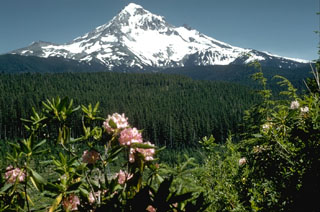Report on Hood (United States) — June 2001
Bulletin of the Global Volcanism Network, vol. 26, no. 6 (June 2001)
Managing Editor: Richard Wunderman.
Hood (United States) Late-1999 mass wasting; January 2001 earthquake swarm
Please cite this report as:
Global Volcanism Program, 2001. Report on Hood (United States) (Wunderman, R., ed.). Bulletin of the Global Volcanism Network, 26:6. Smithsonian Institution. https://doi.org/10.5479/si.GVP.BGVN200106-322010
Hood
United States
45.374°N, 121.695°W; summit elev. 3426 m
All times are local (unless otherwise noted)
After the earthquake swarms in January 1999 (BGVN 24:01), two reports of anomalous activity at Hood were received; in September and October of 2000 landslides and debris flows traveled down the flanks of the volcano, and in January 2001 small earthquake swarms occurred.
The Cascades Volcano Observatory (CVO) reported that intense rainfall during 30 September to 1 October 2000 triggered a series of landslides and debris flows in several of Hood's drainages. The largest flows occurred in White River Valley on the S flank and Newton Creek Valley on the E flank. Both streams were diverted from their channels and severely damaged two sections of Oregon Highway 35; one section is an important link between I-84 and US 26, and the other is a recreational highway that provides access to Mount Hood Meadows Ski Area. The landslides and debris flows caused more than $1 million in damage. The Oregon Department of Transportation reopened the highway on 27 October.
According to CVO, a small earthquake swarm occurred at Hood during 10-19 January 2001. During this period a swarm of 13 earthquakes, with magnitudes ranging from 0.2-2.0, occurred in an area ~4-8 km SSE of the summit at a depth of 4-7 km. This area is frequently a source of earthquake swarms, but this swarm consisted of fewer and smaller events than is typical. The last similar type of swarm occurred in May 2000. On average, 1-2 swarms of small earthquakes occur at Hood each year.
Geological Summary. Mount Hood, Oregon's highest peak, forms a prominent backdrop to the city of Portland. The eroded summit area consists of several andesitic or dacitic lava domes. Major Pleistocene edifice collapse produced a debris avalanche and lahar that traveled north down the Hood River valley and crossed the Columbia River. The glacially eroded volcano has had at least three major eruptive periods during the past 15,000 years. The last two occurred within the past 1,800 years from the central vent high on the SW flank and produced deposits that were distributed primarily to the south and west along the Sandy and Zigzag rivers. The last major eruptive period took place beginning in 1781 CE, when growth of the Crater Rock lava dome was accompanied by pyroclastic flows and lahars down the White and Sandy rivers. The Sandy River lahar deposits extended to the west as far as the Columbia River and were observed by members of the 1804-1805 Lewis and Clark expedition shortly after their emplacement. Minor 19th-century eruptions were witnessed from Portland.
Information Contacts: Cascades Volcano Observatory, U.S. Geological Survey, 5400 MacArthur Blvd., Vancouver, WA 98661 USA (URL: https://volcanoes.usgs.gov/observatories/cvo/).

